Requirement Engineering Assignment: Developing A Specific Online Catalogue for XYZ Pty Ltd
Question
Task:
Requirement Engineering AssignmentTask Instructions:
You should first read and understand the following case before proceeding to answer the questions. Note that every piece of information provided in the following case serves a purpose.
The case
XYZ Pty Ltd is an established company (the 'Company') that has been selling hardware tools and paints for the last 30 years using traditional "brick and mortar" business model, based on tradesmen coming to the store and selecting the goods they want to buy.
They are currently seeking to expand their business to include on-line catalogue with ability to be browsed, select items to be put in the shopping bag and to make an on-line payment with goods either being collected in the store, or shipped via a courier.
The objectives are to increase the sales, to make it more convenient (time saving) for the tradies and also to allow non-trade people to shop on-line.
Thy envisage 20% sales growth.
The Company CEO provided the following very high-level and rough ideas for possible developers:
For customers, they can browse the catalogue, explore particular item's details, add an item to shopping bag, change the number of items, add and delete items to/from shopping bag, select pick-up in the store or delivery to the nominated address and make an online payment or to send an inquiry to the store. Store personnel can respond to the inquiries and contact the customer via email or phone based on the details provided by the customer.
Customers will also have the opportunity to rate and review goods purchased and service provided by the store. Store personnel will be able to respond to the customers' review.
The Company wants to implement the first Minimum Viable Product (MVP) in the next six months and have secured an investment for this. Further investment to finalise the full version in the following six months will be provided on the basis of satisfactory assessment of the MVP implementation.
XYZ has engaged you (i.e. a group of you) as the requirements analyst in this project.
Your task is to document a Software Requirement Specification (SRS) for the proposed app.
Answer
1. Introduction
1.1 Purpose
Here, in the case of requirement engineering assignment, the primary purpose of this report is to specify the specific and significant requirements related to the online catalogue, which has been proposed to be developed by the XYZ Pty Ltd. This document targets to supply a significant understanding regarding the data, process, uses, interface and non-functional requirements as well.
1.2 Document conventions
This document will include the following conventions:
1. ER: Entity Relationship
2. DB: Database
3. OS: Operating system
4. DDB: Distributed database
5. GUI: Graphical User Interface
1.3 Project Scope
The main scope of this project is to design and develop a specific online catalogue for the XYZ Pty Ltdon account of creating a specific and significant platform for the purpose of allowing the organisation to sell their products to their customers via online platform.
2. Overall description
2.1 Product perspective
Theweb catalogueproposed by the XYZ Pty Ltd, include the below-mentioned functions:
1. The web catalogue will record and show product details;
2. It will register the customer details;
3. The customers are capable of purchasing an item from this catalogue by paying the purchase amount through online payment method.
4. The connected DB with this system will record details regarding the customers, product details, service details, work details and transaction details.
2.2 User classes and characteristics
Several use classes are included in this online catalogue, and all of them have different characteristics. These significant classes and their characteristics are noted in the following section:
1. Customer class:
This is one of the important user classes of this online catalogue. The customers can cart products in this online catalogue, as well as canpurchase products by paying the required amount via online payment method. The customer can either pick the purchased product from the store or can request for delivering to their doorstep. Furthermore, they are also capable of submitting significant feedback through this online platform as well.
2. Store persons: This is another major user class of this online catalogue, who are responsible for updating the product stock, managing the products and orders, along with thatgiving order details to the delivery personal for completing successful delivery of an item to the customer’s door step. In addition to that, the store personals are also capable of responding to the customer’s feedback.
3. Delivery boy: Thesestaffs are responsible for delivering the purchased items by the customers to their doorstep. The delivery boys can check the new orders and its delivery date and location in this online catalogue. Moreover, the delivery boys are also capable of updating the shipping status of a product using this online catalogue.
4. Payment manager: The payment managers are responsible for managing all payments done by the customers for purchasing the items.
2.3 Operating environment
Operating environment of this proposed web-application is noted in the following section:
1. Platform: PHP
2. DB: SQL+ database
3. OS: Windows/iOs/android
4. Server/ client system
5. DDB or distributed database
2.4 Design and implementation constraints
The design and implementation constraints are noted in the following section:
1. The application should not consume more than 500 MB of space on the mobile phone(Love, 2018).
2. A string Ethernet connection should be there; otherwise, it would not run successfully.
2.5 Assumptions and dependencies
It has been assumed that an online catalogue would be developed in this case, which will support the XYZ Pty Ltd in order to sell their products to their customers, fruitfully and efficiently. In addition to that, several dependencies are present there, for example, a device for browsing the web application, as well assecure internet connectivity.
3. System features
3.1 Use case diagram
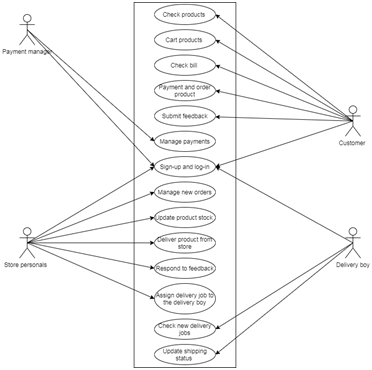
Figure 1: Use Case Diagram
(Source: created by the learner)
3.2 Specification for selected use cases<
|
ID and Name |
UCD-1: Customersign-up |
||
|
Created by |
Student |
Date Created |
10/30/2020 |
|
Primary Actor |
Customer |
Secondary Actors |
System |
|
Description |
This use case is about the registration of new customer with the system, after which they are eligible for purchasing any item from the online catalogue. |
||
|
Trigger |
A new customerwants to register him/herself in the online catalogue by browsing the online catalogue. |
||
|
Preconditions |
1. The new customers need to submit valid and original details to the system; 2. The new customer should fill the entire enquiry form; 3. System checks the originality of the submitted data. |
||
|
Postconditions |
The system will store the registration ID and other details of newly registered customer. |
||
|
Normal Flow |
The normal flow of this use case is listed below: 1. The new customer browse the catalogue; 2. The new customer opens the service provider registration page; 3. Then, the customer fills the entire enquiry form; 4. The customer submits the details; 5. The system checks the originality of the data comparing to the existing data in the database; 6. If it is valid and original, the system will storethe new registration ID along with the other details. 7. In the end, he or she is notified about the successful registration. |
||
|
Alternative Flows |
“Failed registration”: 1. During step 4 of the normal flow, new customer submit duplicate details or don’t submit all details 2. The catalogue will show a failure notification on the screen, and decline the process; 3. The customer re-joined step 3. |
||
|
Exceptions |
Exception 1. if the new customerprovides invalid or duplicate details to the application, then the process will be declined; Exception 2. If the new customer shut-down the system during any step then the entire process will be declined. |
||
|
Priority |
High |
||
|
Frequency of Use |
High |
||
|
Business Rules |
1. The application should check the data’s originality by matching with the database. |
||
|
Other information |
Thenew customer should be connected with a stable Ethernet connection. |
||
|
Assumptions |
It has been assumed that after the successful process completion following the normal flow, the application will enroll the new user successfully, and record all relevant details to the database. |
||
3.3 Swimlane diagram
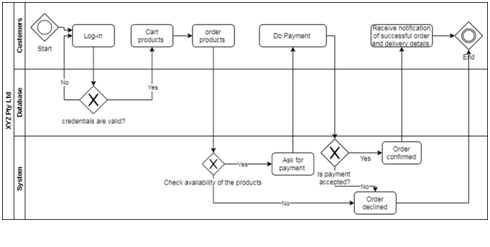
Figure 2: Swimlane diagram for product purchase by customer
(Source: created by the learner)
3.4 State-transition diagram
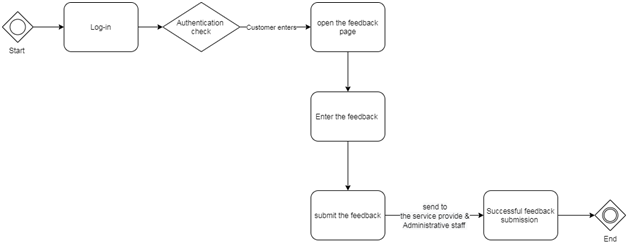
Figure 3: State-transition diagram
(Source: created by the learner)
Here, in this case the user object is having different states for completing the function of feedback submission. The states are:
1. Log-in
2. Authentication check
3. Open the feedback page
4. Enter the feedback
5. Submit the feedback
6. Successful feedback submission
3.5 Dialog map
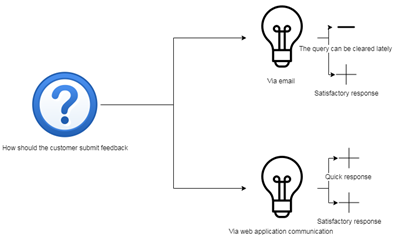
Figure 4: Dialog map
(Source: created by the learner)
4. Data requirement
4.1 Logical data model
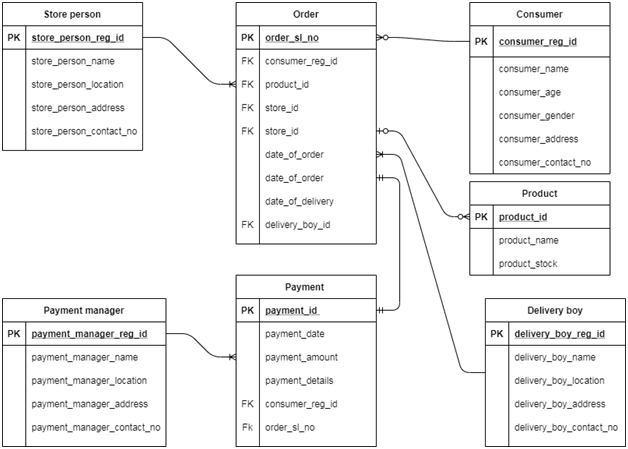
Figure 5: ERD
(Source: created by the learner)
4.2 Data dictionary
|
ID and Name |
UCD-1: Customerlog-in |
||
|
Created by |
Student |
Date Created |
10/30/2020 |
|
Primary Actor |
Customer |
Secondary Actors |
System |
|
Description |
This use case is about giving a user the system access following an authentication check. |
||
|
Trigger |
A customer wants to access the system information |
||
|
Preconditions |
1. The new customers need to submit valid log-in details to the system; 2. The customer should be registered with the system; |
||
|
Postconditions |
The system will give access to the user. |
||
|
Normal Flow |
The normal flow of this use case is listed below: 1. The customer browse the catalogue; 2. The customer opens the log-in page; 3. Then, the customersubmitlog-in details; 4. The system checks the validity of the data comparing to the existing data in the database; 5. If it is valid and original, the system will give the customer access to the system. |
||
|
Alternative Flows |
“Failed log-in”: 1. During step 3 of the normal flow, customer submit wrong details 2. The catalogue will show a failure notification on the screen, and decline the process; 3. The customer re-joined step 3. |
||
|
Exceptions |
Exception 1. If the customer provides invalid details to the application, then the process will be declined; Exception 2. If the customerturn-off the device during any step then the entire process will be declined. |
||
|
Priority |
High |
||
|
Frequency of Use |
High |
||
|
Business Rules |
1. System would check the validity of the given information from the database. |
||
|
Other information |
The customer should have device including chrome browser and should have internet connection. |
||
|
Assumptions |
It has been assumed that the system would be able to give access to the user after performing an authentication check. |
||
5. External interface requirements
5.1 User interfaces
Here, in this case, the user interface standard would be GUI or Graphical User Interface.Moreover, the font size would be different as per the importance of the content; if it is highly essential to show then the size will be 20; otherwise, it can be 16 or 18. The background colour of the interface would be white, and the font colour would be black for all cases. Privacy and copyright notice would be demonstrated at the footer section of the application, and a logical tabbing sequence would be incorporated here as well(Canziba, 2018). Furthermore, the screen size would be different for different screens, such as mobiles, tablets and computers. It will be responsive for all cases. Several standard button or navigation would be present there for all screens, such as log-out, back, help and so forth. The ctrl+V would work for pasting a content, ctrl+C would work for copying text, and prtsc would work for taking snapshots(Reyes-Garcia, 2017). These are some shortcut keys that would be used in this application. Any sorts of notification would be demonstrated in the middle of the screen.Their data would be only accepted in the English language that is the data validation guideline for this application.Process layout would be incorporated for this case. A simple colour combination of white and black would be used in this application as it is usually easy for the colour blinds to read the contents(Canziba, 2018).
5.2 Software interfaces
Several software requirements are present there, such as the system should suitable and storing connection of internet. Any kind of OS like Windows, iOs, and android can be used here. In addition to that a browser like Google chrome is also needed here.
5.3 Hardware interfaces
As software requirements some hardware requirements are also exist, such as the system needs dual core processor. Furthermore, a specific device like mobile, tablet or PC is needed here with 500 MB space in internal memory (Morris, 2017)
6. Quality attributes
6.1 Usability
Some usability requirements are noted down:
1. The functions of this catalogue should be user-friendly.
2. The contents should be acknowledgeable and clearly visible.
3. All functions should work properly.
6.2 Performance
Some performance requirements are noted down:
1. The catalogue should take less than 5 seconds for loading a page or functions if the internet connection is strong(Godbold, 2018).
2. There should be 24/7 availability.
3. There should not be any data redundancy(Buede& Miller, 2016).
4. The catalogue should provide a quick response.
6.3 Security
Some security requirements are noted down:
1. The data and payment should be transacted in an encrypted mode(Shandilya et al. 2018).
2. The data should be accessed only by authorised users(D'Agostino, 2019).
6.4 Reliability
The data gained from the catalogue should be accurate and error-free; thus, it only can be reliable for the users.
7. Other requirements
Some other requirements are mentioned below:
1. All similar resulting buttons and keys should be filled with the same colour;
2. There should several pages included in the application;
3. The catalogue should be maintained routinely, and bugs should be sorted frequently as well.
8. Reference list
Buede, D. M., & Miller, W. D. (2016). The engineering design of systems : models and method (Third). Wiley.https://lesa.on.worldcat.org/oclc/926050644
Canziba, E. (2018). Hands-on ux design for developers : design, prototype, and implement compelling user experiences from scratch. Packt Publishing. https://lesa.on.worldcat.org/oclc/1048772107
Canziba, E. (2018). Hands-on ux design for developers : design, prototype, and implement compelling user experiences from scratch. Packt Publishing.https://lesa.on.worldcat.org/oclc/1048772107
D'Agostino, G. (2019). Data security in cloud computing (First, Vol. Volume ii /, Ser. Computer engineering foundations currents and trajectories collection).Requirement engineering assignmentMomentum Press.https://lesa.on.worldcat.org/oclc/1096507390
Godbold, A. (2018). Mastering ui development with unity : an in-depth guide to developing engaging user interfaces with unity 5, unity 2017, and unity 2018. Packt Publishing. https://lesa.on.worldcat.org/oclc/1035515732
Love, C. (2018). Progressive web application development by example : develop fast, reliable, and engaging user experiences for the web. Packt Publishing.https://lesa.on.worldcat.org/oclc/1048791037
Morris, J. (2017). Hands-on android uidevelopment : design and develop attractive user interfaces for android applications. Packt.https://lesa.on.worldcat.org/oclc/1016976409 Reyes-Garcia, E. (2017). The image-interface : graphical supports for visual information (Ser. Digital tools and uses set, volume 3). ISTE, Ltd.https://lesa.on.worldcat.org/oclc/1008962950
Shandilya, S. K., Chun, S. A., Shandilya, S., &Weippl, E. (2018). Internet of things security : fundamentals, techniques and applications (Ser. River publishers series in information science and technology). River. https://lesa.on.worldcat.org/oclc/1049913527












